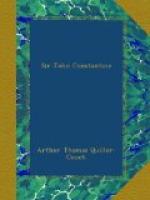It distressed me to find that the Queen Emilia would have none of his courtesies; as I think it distressed him, though he comported himself perfectly. She rejected, and not too graciously, his offer to restore her to her palace at Casalabriva and secure her there against all enemies. From the first she had determined, failing her son’s return, to sail with us to England; and sail she did.
But from the first I doubted her reaching it alive. Her sufferings had worn her out, and it is a matter of dispute between Dom Basilio (who administered the last sacrament), and me whether or no her eyes ever saw the home to which we carried her. They were open, and she was certainly breathing, when we made the entrance of Helford river; for we had lifted her couch upon deck and propped her that she might catch the earliest glimpse of Constantine above the trees. They were open when we dropped anchor, but she was as certainly dead. She lies buried in the private chapel of the house, disused during my brother-in-law’s lifetime, but since restored and elaborately decorated by our Trappist guests. A slab of rose-pink Corsican granite covers her, and is inscribed with the words, “Orate pro anima Emiliae, Corsicorum Reginae,” the date of her death, and beneath it a verse which I took to be from the Vulgate until Parson Grylls quarrelled with Dom Basilio over it—
“CRAS AMET QVI NVNQVAM AMAVIT QVIQVE AMAVIT CRAS AMET.”
As I have said, I had parted with all hope to see my nephew again: and it but confirmed my despair when I received a letter from General Paoli with news that the Prince Camillo had been assassinated; for neither his sister nor Prosper had said word to me of the young man’s treachery, and I concluded that they had bound themselves to rescue him, an unwilling prisoner. In our last brief leave-taking on the island, Prosper had confided to me certain wishes of his concerning the house at Constantine, and the disposal of his estate; wishes of which I need only say here that they obliged me after a certain interval to get his death “presumed” (as the phrase is), and for that purpose to ride up to London and seek counsel with our lawyer, Mr. Knox.
I arrived in London early in the second week of November, 1760—a few days after the decease of our King George II.; and, my business with Mr. Knox drawing to a conclusion, it came into my head to procure a ticket and go visit the Prince’s chamber, near the House of Peers, where his Majesty’s body lay in state. This was on the very afternoon of the funeral, that would start for the Abbey after nightfall, and at Westminster I found a throng already gathered in the mud and murk. In the chambre ardente, which was hung with purple, a score of silver lamps depended from the roof around a tall purple canopy, under which the corpse reposed in its open coffin, flanked with six immense silver candelabra. Between the candelabra and at the head and foot of




